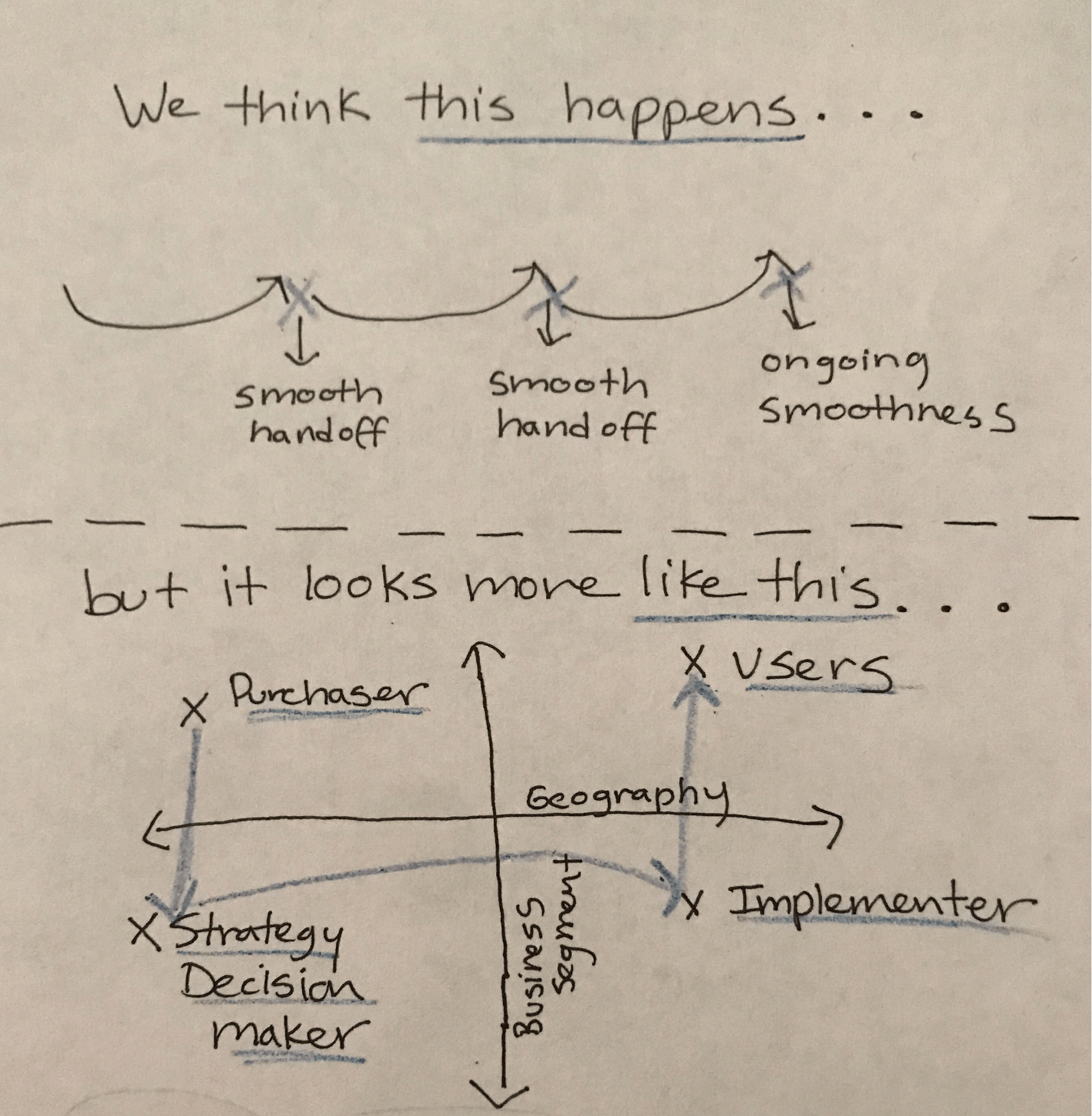
What you draw on a whiteboard is rarely a reflection of real life.
Yet, as leaders of customer success and implementation organizations, we continue to repeat the same mistake.
We map out our idealized versions of what should happen when customers buy our products.
We activate our teams to follow specific processes and wait for strong usage and retention metrics to pour in.
You see, when we write the “should be” story of how someone buys our product, the narrative almost always follows the same script:
- Someone with authority (and budget!) makes a purchasing decision.
- That someone passes the baton to another someone who is ready and willing to implement.
- That someone then passes the baton to another someone (or team of someones) who are ready and willing to adopt. Oh, and we can’t forget…a key to this storyline is that all of this baton passing is a business priority.
But soon, you realize something is broken. The numbers don’t match the whiteboard drawing of your story. You start to have meetings with words like, “gap, dip, plateau, and cliff” in their invite titles. You dig and dig into every adoption metric, searching for the elusive silver bullet.
My take? The real underlying problem is that CX journey diagrams often assume a fluid, linear hand-off path, usually with an imaginary baton and major assumptions about behavior.
Reality often looks much different, and it’s usually much more complex. Our buyers sit in different buildings, geographies, and business units. The people who will end up being the daily users or adopters of your solution might not even know it was purchased, or understand why they should use it at all.
And the disconnect doesn’t end there.
Let’s say your user adoption metrics for a customer are amazing and you head to a customer onsite armed with tons of positive assumptions. But within a few minutes, you realize you only have one power user and teams of people who don’t even know you exist (or, even worse, are unhappy that you do).
I’ve seen this happen first-hand. The success of Drift, for any company, relies heavily on sales and marketing teams working together. I once arrived at a customer onsite, only to discover that the sales and marketing teams had never actually met in person until that day ?
And I have some more #realtalk for you. These adoption gaps and points of friction don’t come up in the user adoption journey because the customer dropped the ball. They happen because WE assumed their path to success followed a clean linear path.

Fixing this doesn’t require a more complex journey mapping exercise. Quite the opposite.
What you need to do is serve up the right experience BEFORE customers lose their away along the adoption journey. Here’s how:
1. For Your Buyer: Point and click product onboarding only will fail. You need to package the end to end vision and communication plan for a successful adoption. Evidence for this can’t just be a conversation with a customer success manager. Your digital library of case studies and success stories is key. So is asking them this direct question, “Are the people who will be setting up and using our product aware of what we do?” You’ll be shocked to realize how frequently the answer is “No” or “I don’t know.”
2. For Your Implementer: Make the experience to implement effortless. If someone is implementing a tool that has been handed to them, they’re far less likely to want to “hop on a call.” How can you empower them through digital education, in-product enablement, and self-service to launch your product?
3. For Your User: Think about the tools you use daily and see results from instantly. A great example is closing the circles on your fitness apps through your watch or phone. How can you create a similar experience for the users of your product so that the results they see are both easy to recognize and motivating. Results buried in downloaded spreadsheets no longer work. Product users of today expect the same experiences they get from the apps on their phone – which means they need to be immediate, simple, and personalized.
Lastly, you can’t fall in love with your story. It might read well, follow best practices, and make your management team happy – but if it doesn’t reflect the reality of how your customers behave, you’ll never see results.
My advice? Get out of your building and step away from your whiteboard.
Stop imagining the “should be” version of your customer journey, and spend time with your customers to understand how they behave in real life.
Where do the teams you need buy-in from sit? How do they engage with each other? What is their relationship like? What do they think your product does? Were they part of the buying process?
All of this knowledge then becomes your secret weapon and gives you the tools you need to write the best (and most realistic) version of your customer adoption story.





